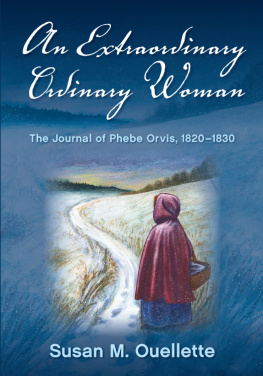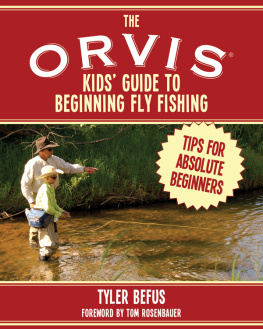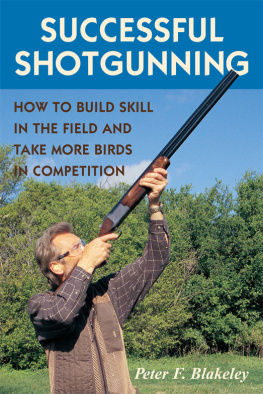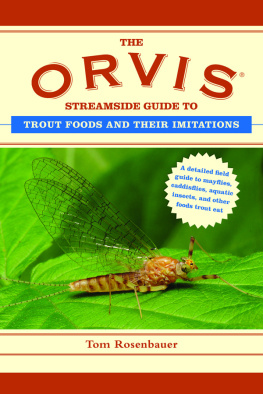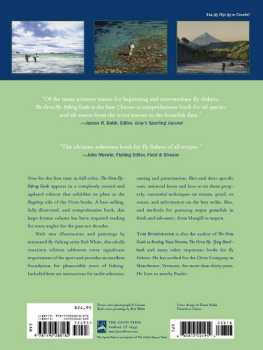
BEGINNING WINGSHOOTING

BEGINNING WINGSHOOTING

Illustrations by
ROBERT L. PRINCE
Tom Deck

S KYHORSE P UBLISHING
Copyright 2013 by Tom Deck
All Rights Reserved. No part of this book may be reproduced in any manner without the express written consent of the publisher, except in the case of brief excerpts in critical reviews or articles. All inquiries should be addressed to Skyhorse Publishing, 307 West 36th Street, 11th Floor, New York, NY 10018.
Skyhorse Publishing books may be purchased in bulk at special discounts for sales promotion, corporate gifts, fund-raising, or educational purposes. Special editions can also be created to specifications.
For details, contact the Special Sales Department, Skyhorse Publishing, 307 West 36th Street, 11th Floor, New York, NY 10018
or
info@skyhorsepublishing.com.
Skyhorse and Skyhorse Publishing are registered trademarks of Skyhorse Publishing,
Inc., a Delaware corporation.
www.skyhorsepublishing.com
10 9 8 7 6 5 4 3 2 1
Library of Congress Cataloging-in-Publication Data is available on file.
ISBN: 978-1-62087-619-0
Printed in China

This book is dedicated to my son J. Hudson Deck. No matter where your life takes you, I only hope that we will continue to enjoy the outdoors together. You are by far the best hunting and fishing partner I could ever have.

Contents
Introduction
WINGSHOOTING IS AN EXCITING PASTIME WITH A RICH tradition. Every year, sportsmen take to the field in pursuit of their favorite game birds. The joys of wingshooting are frequently passed from one generation to the next. Hunters teach their children the rules, lessons, and techniques they have developed over many years spent afield. This passing of the torch includes long years of experience and dedication. One does not become an upland expert overnight, and even the best of bird hunters will admit that perfect days are rare.
Learning to shoot a shotgun can be an intimidating process if you dont know where to begin. My first tip is to find a mentor who has some experience in handling a shotgun. This can be a fun way to learn the basics, providing a go-to person who will take you to the shooting range or maybe even bird hunting for the first time.
Another option is to take shooting lessons or attend a shooting school. This can be the best way to learn some of the fundamental shooting techniques. Also, find and read books on shooting. This shouldnt be the only book you read on wingshooting and shotgunning. There are many wonderful titles you can read and explore. See Tip 96 for more information.
A few items to explain before you dive into this book. I use the words clay, target, and bird interchangeably. Also, most tips are written for the right-handed shooter. If you shoot left-handed (which I do), you will have to switch things around at times.
I have been very fortunate to have worked at the Orvis Fly Fishing and Wingshooting schools for almost twenty years. It has been my great pleasure to work with some very talented coaches. Much of this book comes from my experiences working with them. I have also been lucky enough to hunt and shoot in some wonderful places. The shotgun sports attract all kinds of people, and Ive made many friends along the way.
I wish you all the best with all your shotgunning and upland adventures.
Tom Deck
Manchester, Vermont
May 1, 2013
PART

I
Getting Started
1
Always make safety your
first priority!
AS THE SAYING GOES, SAFETY FIRST. IT ONLY SEEMS FITTING that our first tip cover safety and etiquette. I remember a hunting lodge I used to go to some years back that played an introductory safety video. One of the comments in it was, Youll have a split second to react and a lifetime to remember. That line always stuck in my head. In the field, things can happen lightning fast, and its important that the wingshooter always use good judgment and caution and be in control at all times. This is especially true when you are in the field with other hunters, and when dogs are on the ground.
The simple fact is that firearms can be dangerous, especially when used carelessly. But if you follow some simple rules, bird hunting will be less dangerous than driving your car to the shooting range or to your favorite covert.
Most states require hunters to take a hunter safety course before they can obtain a hunting license. This is a good place to start. You can easily find a listing of courses offered online. These cover the basics of firearms safety. However, it is important that new shooters receive hands-on instruction on how to load and safely handle a shotgun.
At the Orvis Shooting Schools, we have two simple rules that every shooter has to follow: Never point a gun at anything you dont intent to shoot, and treat every gun as if it were loaded, at least until you can verify that it is not. Another rule to follow that makes good sense is to keep the action open at all times when not shooting while continuing to treat the gun as if it were loaded. If it is an over-under or a side-by-side, break the gun open so its chambers are exposed. It is very comforting to other shooters to see a shotgun open or broken when you are not shooting. This is common shooting etiquette and good form, especially at shooting clubs where there tends to be a number of shooters gathered in close proximity.
Safety must always be at the forefront of the wingshooter. I once hosted a trip out West to a hunting lodge. We were hunting upland birds on the open prairie where there were very few trees. It was mostly rolling hills and a few river bottoms. I was matched up with a novice shooter who was very excited about his first bird hunt in Montana. The terrain was wide open, and I thought it would be perfectly suited for this gentlemans first hunt. It was just he and I, a guide, and his dogs.
The hunt started out wonderfully. We shot a few birds early in our hunt, and soon after lunch, we were approaching our limit. My partner was anxious to bag his limit of birds for the day. Pretty soon, the dogs locked up on point. Next thing we knew, a group of huns (Hungarian partridges) flushed out of the prairie. Birds were flying in all directions. In the midst of the action, a few of them flushed behind us. My partner, who had reloaded his gun quickly after the first rush of birds, was already swinging his barrels back behind us. I can still remember looking back over my shoulder as he swung his gun barrels directly across the chest of our guide. Our guides face went white as he put up his hands and shouted, Dont shoot! It was a scary moment. Some ten years later, I can still see the look on our guides face. Luckily, no one was hurt, but it was a lesson to all of us. No matter how open the cover and how safe it seems, you must always be in control of your gun barrels. Always put safety first, and always err on the side of caution.


